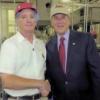Hi Noahcris97,
I just started with this network so I know my post is late, but I hope it helps:
If you would like to know if there is any updated on the set limits, you need to contact Charms…although the most current that I have by Charms is below.
Stainless Steel RLU = 1000
Teflon RLU = 4500
Plastic RLU = 2500
Aluminum RLU = 6000
Rubber RLU = 4500
I don’t have the other elements you mention in your first post: Nylon ,Teflon, Dairy
Water
My suggestion is: if there isn’t any record of how the settings were completed, you will probably need to start working on it.
There is coupe ways to do it. First contact Charms and they will send you the procedure how to set your limits….This procedure requires micro testing. If your boss is willing to add this to the sanitation budged it will be great for you to learn something new. The Staff from Charms is very helpful with this matter. Note: Charms always recommend validating your limits regardless of thiers.
Other way to do it is to select the areas you would like to add to your routine ATP swabbing and create a check list. Every time those areas are cleaned you will need to swabbed and record the RLU results---this can be done at least after 30 clean ups so that you can have enough data to review. Every day you will get different results. After you review the results you will pick the lowest result and make it as start point (set limit) But continue observing the trend at least for the next six months just to see if you can get lower RLU.
I work in a meat facility we been using Charms for years. So base on our continuously persistence to get lower results (believe or not) in our food safety plan, for all the surfaces the RLU must be 0 (cero) this includes Aluminum, SS, plastic, rubber. We although do not have Nylon, Teflon in our operations.
For Dairy I suggest continue following the RLU 350 and if you would like to go lower then test double rinsing…When I used to work in another facility we conduct a triple rinse and then ATP. The ATP was set after a data with one rinse, double rinse and triple rinse was reviewed.
I hope this helps 














